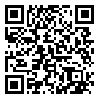Volume 4, Issue 3 (Autumn 2001)
J Arak Uni Med Sci 2001, 4(3): 1-6 |
Back to browse issues page
Download citation:
BibTeX | RIS | EndNote | Medlars | ProCite | Reference Manager | RefWorks
Send citation to:



BibTeX | RIS | EndNote | Medlars | ProCite | Reference Manager | RefWorks
Send citation to:
Azizi F, Sheikholeslam R, Mirmiran P, Abdolhosini G, Kimiagar M, Malekafzali H. Goiter Survey and Urinary Iodine Concentration in School Children Aged 8 to 10 Year of Markazi Province in 1996. J Arak Uni Med Sci 2001; 4 (3) :1-6
URL: http://jams.arakmu.ac.ir/article-1-6670-en.html
URL: http://jams.arakmu.ac.ir/article-1-6670-en.html
Fereydoun Azizi1 
 , Robabeh Sheikholeslam2
, Robabeh Sheikholeslam2 
 , Parvin Mirmiran3
, Parvin Mirmiran3 
 , Gita Abdolhosini4
, Gita Abdolhosini4 
 , Masoud Kimiagar5
, Masoud Kimiagar5 
 , Hossein Malekafzali6
, Hossein Malekafzali6 


 , Robabeh Sheikholeslam2
, Robabeh Sheikholeslam2 
 , Parvin Mirmiran3
, Parvin Mirmiran3 
 , Gita Abdolhosini4
, Gita Abdolhosini4 
 , Masoud Kimiagar5
, Masoud Kimiagar5 
 , Hossein Malekafzali6
, Hossein Malekafzali6 

1- Professor and Head of Endocrine and Metabolism Research Center.
2- Faculty Member of Ministry of Health & Medical Education.
3- Faculty Member of Shaheed Beheshti University of Medical Sciences, Tehran, Iran.
4- M.D.
5- Professor of Shaheed Beheshti University of Medical Sciences, Tehran, Iran.
6- Professor of Tehran University of Medical Sciences, Tehran, Iran.
2- Faculty Member of Ministry of Health & Medical Education.
3- Faculty Member of Shaheed Beheshti University of Medical Sciences, Tehran, Iran.
4- M.D.
5- Professor of Shaheed Beheshti University of Medical Sciences, Tehran, Iran.
6- Professor of Tehran University of Medical Sciences, Tehran, Iran.
Abstract: (2250 Views)
Introduction: Iodine deficiency disorders (IDD) is a worldwide health problem. Many parts of the Islamic republic of Iran had been known as areas of endemic goiter. IDD was accepted as a priority health problem in the country and a National IDD Council was formed in 1989.
Material and Method: One of the main strategies of National Council for IDD control was to provide at least 150mg of iodine per day to the entire population through making available iodized salt. This study was performed to evaluate the National IDD council program in 1996, in rural and urban areas of Markazi province, 1300 school children, aged 8 to 10 years, including 50% boys, were selected through random sampling Grading of goiter was performed according to WHO. Classification, Serume, T3, T4 and TSH were measured by RIA and urinary iodine by digestion method.
Results: The mean of serume T3, T4 and TSH were: 10±2.0 μg/dl, 160±28 ng/dl and 2.3±1.3 μIu/ml respectively. There were no differences between males and females and school children of rural or urban areas. Four person had serum T4 more than 12.5μg/dl. The mean urinary iodine was 16mg/dl in entire population. 75% had urinary iodine more than 10mg/dl. Only 11% had urinary iodine less than 5μg/dl. Total prevalence of goiter was 35% (36% in girls and 34% in boys).
Conclusion: Based on the available data, seven years after distribution of iodized salt, urinary iodine of school children of Markazi province does not show iodine deficiency. However goiter is still endemic in Markazi province.
Material and Method: One of the main strategies of National Council for IDD control was to provide at least 150mg of iodine per day to the entire population through making available iodized salt. This study was performed to evaluate the National IDD council program in 1996, in rural and urban areas of Markazi province, 1300 school children, aged 8 to 10 years, including 50% boys, were selected through random sampling Grading of goiter was performed according to WHO. Classification, Serume, T3, T4 and TSH were measured by RIA and urinary iodine by digestion method.
Results: The mean of serume T3, T4 and TSH were: 10±2.0 μg/dl, 160±28 ng/dl and 2.3±1.3 μIu/ml respectively. There were no differences between males and females and school children of rural or urban areas. Four person had serum T4 more than 12.5μg/dl. The mean urinary iodine was 16mg/dl in entire population. 75% had urinary iodine more than 10mg/dl. Only 11% had urinary iodine less than 5μg/dl. Total prevalence of goiter was 35% (36% in girls and 34% in boys).
Conclusion: Based on the available data, seven years after distribution of iodized salt, urinary iodine of school children of Markazi province does not show iodine deficiency. However goiter is still endemic in Markazi province.
| Rights and permissions | |
 |
This work is licensed under a Creative Commons Attribution-NonCommercial 4.0 International License. |



